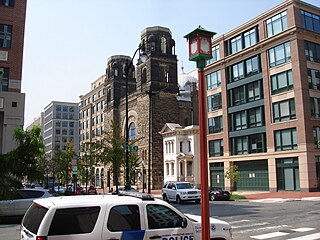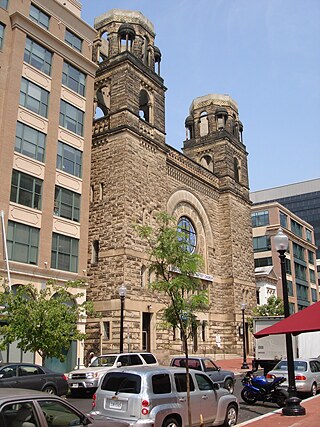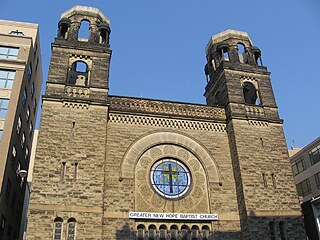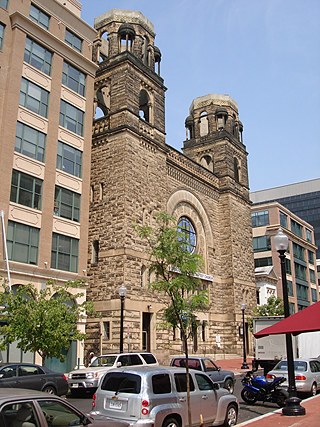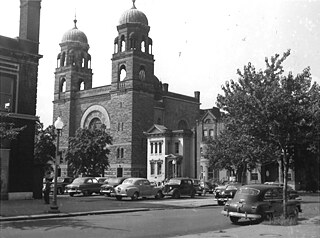Greater New Hope Baptist Church
German Roots in DC
Washington Hebrew Congregation, Washington's oldest Jewish congregation, was formed in 1852 and is associated with Reform Judaism. The congregation, originally essentially German, dedicated its 8th Street temple in 1898. President William McKinley attended the ground-breaking ceremonies.Although not a copy of the famous Berlin Synagogue on Oranienburger Strasse, dedicated in 1866 and designed by Eduard Knoblauch, Washington's 8th Street Temple is reminiscent of the 3200-seat Berlin synagogue. Both buildings, in turn, recall the famous Dresden Synagogue built by Gottfried Semper in 1840. The building has been home to Greater New Hope Baptist Church since 1954, the church having been organized in 1933. Washington Hebrew Congregation is now located at 3935 Macomb Street, N.W.
Listen to local historian and tour guide Carl Saperstein share his recollections about Washington Hebrew Congregation and the role his and other German-American families played in Washington
John Phillip Wymer, Photographer
About John Philip Wymer
(October 19, 1904 - January 12, 1995)
From an article by Charles Paul Freund, "Photo Synthesis: Midcentury Washington from a Man on the Street's Capitol View," Regardie's, May 1986, pp. 56-59
One weekend morning in the spring of 1948 a resident of Cleveland Park swung out of bed and embarked on a mission he'd been mulling over for some time: capturing Washington. John P. Wymer was no general; he was a statistician at the nearby Bureau of Standards. But he was a methodical and remarkably single-minded man, and by the time he was done Washington had become his in ways that such besiegers as Admiral Cockburn and Jubal Early could never claim.
Wymer's idea was to make a photographic record of Washington, all of it, neighborhood by neighborhood, virtually block by block. The project took him until 1952-four years of weekends and vacations. In the process he snapped about 6,000 black-and-white photographs, discarding a third of them and pasting the rest into some 50 photo albums. Washington has inspired a number of large-scale photographic projects, both amateur and professional, but Wymer's 4,000 images make up the most extensive and wide-ranging one-man effort that has yet surfaced.
Wymer carefully grouped his pictures by area; he split the city (omitting the suburbs altogether) into 57 sections that were keyed to a map he created for the purpose. Each area is introduced by a painstakingly typed descriptive and historic preface and features "sample blocks" (the statistician's mind at work). Every shot has a short typed caption pasted under it, identifying it and, in most cases, giving the date Wymer photographed it.
Why'd he do it? Essentially because it was there.
"I thought it would make a nice hobby for me," says Wymer, who's 81 and still lives in Cleveland Park. He was neither an inveterate photographer nor an amateur historian. In fact, he isn't even a native Washingtonian; he had come to DC from California 10 years before starting his project.
It was all just a way to pass the time, he says, that "came to me out of my own head."
But if there were a muse of photography, one might be tempted to think of Wymer's project as a classically inspired obsession, for pressed between the photo albums' cheap pages, which are already brittle and crumbling, is a Washington that's been caught in remarkable variety at a singular moment. Wymer's Washington is a far smaller national capital basking in the sun (all of his shots were taken on nice days) just after its explosive World War II growth and just before suburbanization and the aftereffects of school integration altered the city forever.
. . .
Wymer finished the shooting, selecting, cataloging, typing, and pasting in the early 1950s, and then put his giant stack of albums away. Except for a few times when he showed them to interested friends, he rarely opened them again. In 1978 James Goode, the author of Capital Losses and one of the city's premier social historians, was told about them while he was searching for a shot of an all-but-forgotten downtown restaurant. Goode immediately recognized the collection's value as a portrait of a fast-disappearing community. He notified the Columbia Historical Society, and soon afterward Wymer deposited his albums, negatives, and guide map there.
